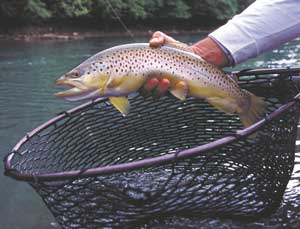
Although it’s possible to fish for trout throughout the year in South Carolina, the cooler weather September ushers in considerably thins the number of anglers. For some, Labor Day — usually the first weekend in September — ritually marks the end to their fishing season and the beginning of other activities, such as hunting or football games.
Yes, there are no longer luxurious hatches of caddis and Mayflies on the water. The stocking truck isn’t making its appointed rounds depositing pellet-laden, ready-to-catch trout to the local hot spots at rivers. But those who forgo this important time of seasonal transition are missing some of the best fishing of the year.
Consistently-good anglers know transitions are the keys to success — those between day and night, deep and shallow water, slow and fast current, structure and open water. These edges of time and space have always been the starting points when searching for fish.
But no other transition is more significant than the changing of the seasons. September kicks off one of the most important transition periods of the year for trout or fly anglers.
This month officially marks an end to summer and the advent of autumn. Fish don’t read or consult calendars, but they detect subtle changes in water temperature and amounts of diminishing daylight with each passing day.
The cooling water temperatures of September cause trout to feed more aggressively, particularly toward the end of the month. This is part biology, part instinct.
The cooler water temperatures ratchet up trout metabolisms, which leads to the need for more food to function. That’s the biology. There is also a detectable urgency— and later, desperation perhaps — as the fish try to eat as much food as possible and fatten up before winter arrives. This is the instinct part, although I’m sure biology is a factor as well.
Brown and brook trout have to feed more energetically to build up reserves for their October and November spawning runs. During this time, both species adorn some of the most outrageous hues of red, yellow and orange along their flanks — not coincidentally, the same colors spreading along the trees and riparian river edges. The subtle temperature changes in September trigger this change as well — another transition anglers can use to their advantage.
During early September, the fishing doesn’t differ much from typical summer fly fishing. The water is warm and the fish are still lethargic after a long summer. Water levels in the rivers and streams are low and extremely clear. Terrestrial fly patterns fished early and late in the day with anglers using long leaders and light tippets will be the best bet to catch fish at this time.
As the month progresses, terrestrials such as hoppers, crickets and ants will still work, but the fish aren’t as convinced as they were earlier. Imitations of aquatic insects will again take fish with regularity.
Blue-winged olives, blue quills, caddis and midges will appear with more frequency as water temperatures drop, although not the quantity found in the spring. Streamers also will catch fish again as trout become more aggressive.
Fishing during September also has a great advantage over typical autumn fly fishing. This period is what I like to call the “pre-leaf autumn,” as water temperatures have dropped and trout are feeding more actively. But there’s none of the frustration in dealing with the leaf falls and resulting fouled hooks.
By mid-October, the joys of cool, crisp, Indian-summer days and fall foliage quickly can fade as each cast collects a wad of soggy leaves.
September can be some of the best fly fishing for trout during the entire year.
So instead of sitting on the couch each weekend and watching endless football games, wet a line before the leaves and later the cold ruin all the fun.



Be the first to comment